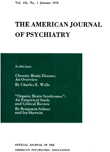DRUG USE-RATE IN A STATE HOSPITAL
Abstract
Use-rates for 9 tranquilizing and 3 stimulant drugs or drug-combinations were recorded in a state hospital population over a 4 year period, ending December 31, 1958. Data were plotted graphically, and userates were observed in descending order for chlorpromazine, promazine, reserpine, proclorpromazine, meprobamate, triflupromazine, mepazine, mepazine plus chlorpromazine, reserpine plus chlorpromazine, benzedrine, methylphenidate, and iproniazid.
By the end of the observation period, 61% of the total hospital population, (21% of the male, and 40% of the female populations) were receiving one or more of the drugs. Of the total, male, and female populations on drugs, 34%, 11%, and 23% respectively were receiving chlorpromazine.
Access content
To read the fulltext, please use one of the options below to sign in or purchase access.- Personal login
- Institutional Login
- Sign in via OpenAthens
- Register for access
-
Please login/register if you wish to pair your device and check access availability.
Not a subscriber?
PsychiatryOnline subscription options offer access to the DSM-5 library, books, journals, CME, and patient resources. This all-in-one virtual library provides psychiatrists and mental health professionals with key resources for diagnosis, treatment, research, and professional development.
Need more help? PsychiatryOnline Customer Service may be reached by emailing [email protected] or by calling 800-368-5777 (in the U.S.) or 703-907-7322 (outside the U.S.).



